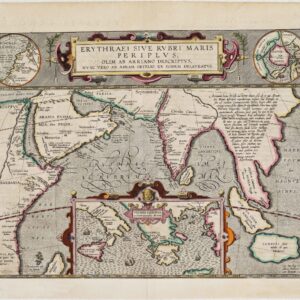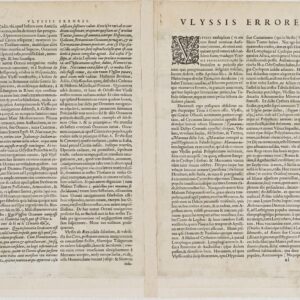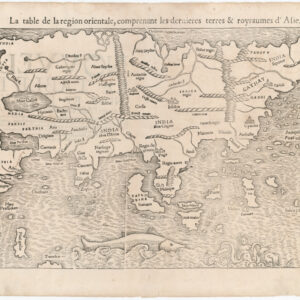A milestone in the mapping of the Korean Peninsula.
Tcheng-Te Fou. Moukden. Vladivostok.
Out of stock
Description
This monumental wall map of the Korean Peninsula and surrounding regions was produced in 1904 by the cartographic unit of the French Army, also known as the Service Géographique de l’Armée. The map is a topographic compilation consisting of nine individual sheets, which have been joined and mounted on linen for display and improved longevity. In addition to the Korean Peninsula itself, the map includes large swathes of Northeastern China and Russia, including the eastern city of Vladivostok. As the map consists of individual sheets that have been combined to form a broader map of the region, there are three visible titles along the top of this map (Tcheng-Te Fou; Moukden; and Vladivostok). We have reused these as the map’s general title.
A high-grade product of the French military, the map is highly detailed, showing a cornucopia of toponymic, physiographic, and geographic information. Also important is the careful rendering of crucial infrastructure, such as rail lines, roads, rivers, ports, and cities (e.g. Beijing, Nanjing, Seoul, Port Arthur/Lüshunkou, and Vladivostok) are all marked on the map.
This wall map is part of a broader series of French military maps aiming at global coverage. The maps of Service Géographique de L’Armée could be used both as stand-alone sheets or combined for greater regional coverage, as has been done here. The purpose of this particular map was to aid French officers and politicians in the visualization of the Russo-Japanese War (1904-05), which had reached its zenith right when this map was issued (see context section below). It is thus a reflection of the West’s interest in the conflict between Tzarist Russia and Imperial Japan.
In addition to Korea itself, the focus is on the two smaller peninsulas of Liaodang and Chan-Toung. The Russian railroad traversing the Liaodang Peninsula was a crucial infrastructure that connected Mukden (Shenyang) with Port Arthur (Lüshunkou), the most important Russian naval base at the time. Indeed, every stop on this line has been carefully marked on the map, underscoring the importance of this railroad for the Russian war effort. Despite being on Chinese Territory (Manchuria), Mukden- especially Port Arthur – saw some of the fiercest fighting in the Russo- Japanese War.
Context is Everything
The Russo-Japanese War (1904-1905) was a conflict between Imperial Japan and Tsarist Russia, driven by their rival ambitions in Manchuria and Korea. Russia, aiming to expand southwards, acquired Port Arthur as a warm water port in 1898, while Japan sought to establish itself as the dominant force in East Asia. Japan proved its strength by launching a surprise attack on the Russian Eastern Fleet at Port Arthur, leading to a series of Russian defeats.
U.S. President Theodore Roosevelt mediated a peace treaty known as the Treaty of Portsmouth, which acknowledged Japan’s claims on Korea and required Russian forces to withdraw from Manchuria and Port Arthur. This unexpected victory by Japan reshaped the balance of power in East Asia and solidified its position as the leading regional power. Moreover, it was a tremendous political embarrassment for Russia and contributed significantly to the fall of the Romanov Dynasty and the Russian Revolution.
Census
The nine sheets from which this wall map was created were all compiled and published by the Service Géographique de l’Armée in 1904. While our map sheets are dated along the bottom, an undated edition from the same year also exists, in which the sheets are joined to create a large folding map. This edition was issued in a slipcase with the gold embossed title: Extremo Oriente. While the combined map showing the full Korean Peninsula is scarce in any state, the individual sheets occasionally appear on the market but are quickly snatched up by collectors. The complete map of Korea and its surrounding regions is nevertheless rare.
Some of the titled sheets are listed in the OCLC but seldom include accessible institutional examples. Thus, while Tchen-Te Fou (OCLC no. 908336799) has no institutional listings; the Mukden sheet (OCLC no. 1129252857) is listed in five different French libraries; and when it comes to the Vladivostok sheet, the OCLC only lists holdings of the 1899 (52866672) and 1918 (908441880) editions.
Cartographer(s):
The Service Géographique de l’Armée was the mapping service of the French Army between 1887 and 1940, when the Second World War saw the entire French Army – including its cartographic unit – disbanded.
Condition Description
Very good. Minor discoloration in some places. Nine sheets on new linen.
References
![[Northern India and Pakistan] Tabula Asiae IX.](https://neatlinemaps.com/wp-content/uploads/2023/07/NL-00244-NEW_thumbnail-300x300.jpg)
![[Sri Lanka] Tabula Duodecima Dasia](https://neatlinemaps.com/wp-content/uploads/2023/03/NL-01721_thumbnail-300x300.jpg)


